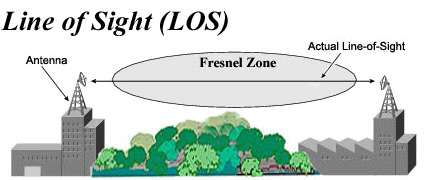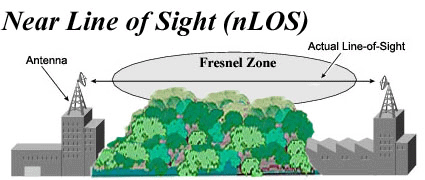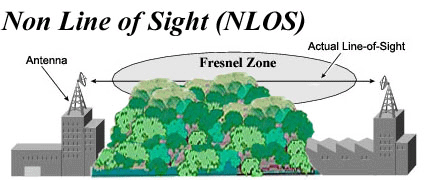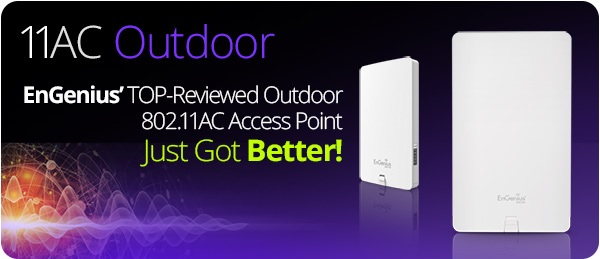Increasing the Range of your 802.11 Wireless Network
If you currently have an existing wireless network and are unhappy with the range that you are getting, or just want to go further then here are some tips of what you can do to boost the range of your own wireless network, or create a Wireless Bridge between two remote locations. Before you proceed, remember that wireless is a two way system, both the Access Point and Client Device must be communicating at a equal level before a secure, reliable, wireless connection can occur.For a professional site survey of your home or small office please contact us today, and avoid purchasing the wrong WiFi antenna for your wireless network.
Transmit Power
The power usually expressed in mW or dbm, that the wireless device transmits at. Most Linksys, Dlink, Netgear, Ubiquiti and other indoor, home based access points use a 32-100mW transmit power. This is one of the main reasons signal strength is limited when using these devices. The higher the transmit power, generally, the more flexibility you will have in sending out a long range, wireless network signal. GNS Wireless stocks high quality, outdoor, weatherproof access points, with adjustable transmit power levels up to 30dBm, or 1000mW.
Receive Sensitivity
The level of signal the wireless device needs to receive in order to make a connection. Most wireless devices require a stronger signal to pick up a connection at 11Mbps than one at 1Mbps. The higher the receive sensitivity of a client card, or an access point, the better quality signal it will pick up, and the easier it will be for you to send or receive a signal at farther distances. When designing a outdoor wireless network, choose a better quality access point for a more reliable signal.
Antenna Gain
Although antennas don’t increase the transmit power, they will increase the signal strength, and focus the signal depending on what type of high gain antenna you use. So instead of the stock antenna transmitting in every direction, high gain antennas will focus the signal usually either more horizontally/vertically or in one particular direction. This gain is measured in decibels. Basically the higher the gain antenna, the farther it will transmit. Also the higher the gain antenna, the shorter, or narrower the radiation pattern will be. Antenna selection should be based on a application to application basis, as there is not a one size fits all. Going with the largest antenna gain will not necessarily give you the best signal.
Noise Level
This is the strength of the background noise that the wireless device is picking up. With no noise, you will show a -100db. 900MHz wireless networks tend to be the most prone to interference. 5.8GHz backhaul bridge packages, and 2.4GHz wireless networks will not interfere with one another, which is one of the reasons we use it in this type of configuration.
Signal to Noise Ratio
This is the difference between the strength of the background noise and the strength of the signal. If the noise is greater than the signal, then no signal will be picked up. If the noise is only just less than the signal then there will be lots of lost packets. The greater the difference in SNR, the stronger your signal will be. When you connect a high gain antenna onto a wireless device, the antenna gain acts on both the transmit power and receive sensitivity, so you are not only sending your signal further (in a more focused direction), but your are also able to listen to weaker signals. Please note that the maximum ERP allowed by the FCC is 36dbm, or 4 Watts.
Upgrade the Wi-Fi Antennas on the Wireless Router or Access Point.
If you have one of the many types of Linksys, D-Link, Netgear, Cisco, Proxim, or Belkin Wireless Routers, then you have the ability to upgrade both of the antenna that are come stock on the device to a stronger gain antenna. Depending on what you are communicating to wirelessly, how far away the device is, and the construction of your home or office will determine the antennas that will be right for you. Please contact us for more information.
Extending the range of your LAPTOP. (PCMCIA card)
This is usually the first problem when it comes to poor performing wireless network. Upgrading the antennas on a router, while still using an old or underachieving PCMCIA card in your laptop will not get you better range. ALWAYS upgrade the laptop, or desktop card FIRST, before upgrading the antennas on your router.
If you are using a laptop with the built in Centrino wireless technology, while convenient, this internal wireless card does not get very good distance when trying to connect to a Wireless Access Point more then 50 feet away. Upgrade to a better PCMCIA card, like the ZyXel B-101, or Proxim OGOLD, and you will see a difference right away.
If you are using a laptop to access the internet or other files wirelessly, and are not getting the desired range, or just want to go further with it, then you will need a PCMCIA card with a upgradeable antenna option. We recommend that you upgrade to a ZyXel B-101 card. This PCMCIA card has a great Receive Sensitivity and also has a connector on it which allows for the addition of an external antenna.
Extend the Wireless range of your DESKTOP. (PCI Card)
When using a desktop to communicate wirelessly, you have many options of what to use to extend the range of the wireless signal. You can use a Client device, such as a Linksys WET11 or WET54G. You can use a USB adapter, which is easy to install, but does not offer much range. You can also use a PCI card, which you must install inside the computer, but usually has a removable antenna that you can upgrade. Such a device is the Linksys WMP11, WMP54G, D-Link DWL-G520 or the ZyXel G-300. These devices can adapt to an external antenna and are great for extending the range of your wireless network.
The problem with using a PCI card is that usually the card sits behind the computer, and the computer is behind the desk. This means that the wireless signal has to work twice as hard to communicate with the wireless access point. The solution is to purchase a small external antenna, that you can place on top of the desk or bookcase, and get the antenna out from behind the computer. We recommend the D-link DWL-M60 for this application..
Extend your wireless network to your friends and neighbors.
If you have a high speed connection, and a wireless router, you have a variety of choices as what to do with it. You can roam the house with your laptop, share internet with your neighbors, and even set yourself up as a small Internet Service Provider, or WISP. Sharing your internet connection with friends and family is easy as upgrading the antennas on your wireless Access Point, and telling your neighbors to do the same. Although the type of antenna needed will be different in each application, you can check out some of the antennas used, by visiting our Wi-Fi Antenna page, or by contacting us, and letting us know what your trying to do. We have been installing Wireless Hotspots in every type of application you can imagine, give us a call and see how we can help.
Wireless Line-of-Sight
Outdoor Wi-Fi Range:
The range of a wireless link is dependent upon the maximum allowable path loss. For outdoor links, you will get a strong signal as long as there is clear Line-of-Sight between the two antennas with sufficient clearance for the Fresnel zone. For Line-of-Sight, you should be able to visibly see the remote locations antenna from the main site. (Longer distances may require the use of binoculars). There should be no obstructions between the antennas themselves. This includes trees, buildings, hills, concrete, steel, power lines, or a drastic change in elevation, etc. As the distance extends beyond six miles, the curve of the earth (commonly called earth bulge) affects installation, requiring antennas to be placed at higher elevations. Use the 24dBi grid antennas for distance this far, or contact one of our technical consultants for a free path analysis. Please contact us to discuss your Wireless application, as there are variables dependant on transmitting a strong, reliable wireless signal.
Point-to-Point Wireless Bridge and Point-to-Multipoint Bridging:
What is Point-to-Point? When connecting two points together (Also referred to as a Wireless Bridge kit), the distance, obstructions, and antenna height as well as location must be considered. If the antennas can be mounted indoors and the distance is not far (several hundred feet), the standard dipole or upgraded 7dBi Omni-directional may be used.
An alternative is to use two patch antennas for your Wireless Point-to-Point Bridge Kit. GNS Wireless offers complete Wireless Bridges that include everything you need to wirelessly connect your two locations safely and securely.
For longer distances (1/4 mile or more), directional, high-gain antennas must be used. With the use of directional antennas, fewer interference possibilities exist and there is less possibility of causing interference to anyone else. These antennas should be installed as high as possible, and above obstructions such as trees, buildings, and other physical obstructions. These antennas should be pointed at each other, as much as possible. With a line-of-site configuration, distances of up to 25 miles at both 2.4 GHz and 5 GHz can be reached using 24dBi grid antennas, or backhaul radios from Cambium or Proxim Wireless. Contact one of our certified techical support professionals for more information.
What is Point-to-Multipoint Bridging? In this case (in which a single point is communicating to several remote points), the use of an Omni-directional antenna at the main base station point should be used. The remote sites can use a directional antenna that is directed at the main point antenna. If the multiple distance range farther then 1000 feet, multiple sector antennas should be used at the base station point. These antennas range anywhere from 60 degrees to 180 degrees of coverage. Using a Sector Antenna for the main location of your Point to Multipoint Wireless Bridge Kit will give you the best signal strength to all locations.
Line-of-Sight | near Line-of-Sight | Non Line-of-Sight:
Each Wireless Bridge Kit requires Line-of-Sight between the two locations unless otherwise specified. For Non Line-of-Sight Wireless Bridge Kits, please contact us to discuss in further detail your particular situation. If your two locations are completely obstructed by trees, you may also be interested in our 900MHz point to point solution, part number GNS-1130N.
Non Line-of-Sight Wireless Bridge Kits use Multi-Path antenna designs which allow the signal to be received in a multi-path instead of just vertical or horizontal. Please view the images below as example of different LOS issues. You can also use the 900MHz, as mentioned above, which have tree penetration ability, as the lower frequency can penetrate the trees much more effectively then the 2.4GHz, or 5.8Ghz.

Line-of-Sight means that at each location in your Wireless Bridge, the antenna that is mounted, will be able to see the opposite antenna clearly, with no obstructions. Even the slightest tree branch moving in the wind can cause dropouts in the wireless connection. Choose a Wireless Bridge Kit that has directional antennas, and a high gain antenna that meets your needs. For good throughput, look for a wireless radio that has low latency, and good receive sensitivity, combined with enough transmit power to connect your two buildings.

Near Line-of-Sight Wireless Connections will have minimum tree coverage in between the two locations of the Wireless Bridge. You want to choose a Wireless Bridge Kit that has a high gain antenna, or even move to a Non Line of Sight Wireless Bridge, to connect your two locations.When you are attempting to connect two locations together wirelessly, and have a fewtrees in between, you can sometimes use a better quality 2.4GHz radio to connect thetwo buildings, as a radio with good receive sensitivity will give you a solid connection.
Some obstructions that will decrease the wireless signal are as follows:
|
|

If your Wireless Bridge has is completed obstructed between the two points, and has No Line of Sight, then you want to purchase a NLOS Bridge Kit, or move to a different frequency such as a 5GHz Bridge Kit. Please contact us to discuss your situation further, as there are many variables to consider when selecting a Non Line-of-Sight Wireless Bridge Kit.


